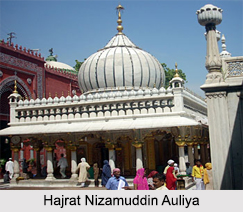 Hajrat Nizamuddin Auliya was one of the most renowned and revered Sufi Saints of India. Hajrat Nizamuddin Auliya and his disciple Amir Khusro were largely responsible for taking Sufism to every nook and corner of India. One of the most renowned and revered Sufi saints, Hajrat Nizamuddin Auliya was a disciple and chief successor of Baba Farid. Nizamuddin was born in Badaun in 1236 AD. At the age of five years he lost his father. His mother, who was a very pious lady, therefore, brought him up. It is said that at times they did not have any food to eat in the house. On such occasions she used to say to her son `today we are the guests of God`. Her trust in God was extraordinary. The young Nizamuddin was thus greatly influenced by this saintly character of his mother.
Hajrat Nizamuddin Auliya was one of the most renowned and revered Sufi Saints of India. Hajrat Nizamuddin Auliya and his disciple Amir Khusro were largely responsible for taking Sufism to every nook and corner of India. One of the most renowned and revered Sufi saints, Hajrat Nizamuddin Auliya was a disciple and chief successor of Baba Farid. Nizamuddin was born in Badaun in 1236 AD. At the age of five years he lost his father. His mother, who was a very pious lady, therefore, brought him up. It is said that at times they did not have any food to eat in the house. On such occasions she used to say to her son `today we are the guests of God`. Her trust in God was extraordinary. The young Nizamuddin was thus greatly influenced by this saintly character of his mother.
At the age of twenty years, Nizamuddin heard from some one about Baba Farid, who had then taken Ayodhya as his abode. So impressed was Nizamuddin that he immediately set for Ayodhya and on reaching there he surrendered himself at the pious feet of Baba Farid, who took Nizamuddin immediately as his disciple. In due course, Baba Farid appointed Shaikh Nizamuddin as his Vicegerent and asked him to go Delhi. On coming back to Delhi the fame of Hajrat Nizamuddin started reaching far and wide. Lots of people started visiting him to seek his blessings. This made the King Mubarak Khilji somewhat apprehensive of his influence over the people and especially so as Hajrat Nizamuddin made it a point not to pay ceremonial visits to the King.
In his relationship with the Kings, Nizamuddin was always more powerful. King Mubarak Khilji used to hold a special court on the appearance of the new moon when all the leading personalities of the city used to pay courtesy visit to him. Hajrat Nizamuddin, however, never visited the King even on these occasions. Once, King Mubarak Khilji threatened to severely punish Hajrat Nizamuddin if he failed to visit him on the next new moon. Hajrat Nizamuddin who used to frequently visit his mother`s tomb, prayed before her for the death of the King before the appearance of the next new moon. It so happened that at the appearance of the next new moon, a person named Khusru Khan killed King Mubarak Khilji. Later, Ghiyas ud din Tughlaq in turn killed Khusru Khan. The new King also was apprehensive of Hajrat Nizamuddin, like his predecessor. He ordered Hajrat Nizamuddin to leave Delhi. It is reported that in 1325 AD, Ghiyas ud din Tughlaq on returning from a successful expedition in Bengal, sent word to Hajrat Nizamuddin to quit Delhi. When the royal command was announced to Hajrat Nizamuddin he uttered, `Hanoz Dilli Dur Ast` meaning Delhi is still far off. Ghiyas ud din Tughlaq could not make to Delhi. At Tughlakabad, a pavilion erected in his honour fell over him and he was killed in this accident.
Amir Khusro was a devoted disciple of Hajrat Nizamuddin. He was a poet who used Urdu for the first time to compose songs, riddles, rhymes and enigmas in common man`s language to reach their hearts. Hajrat Nizamuddin along with Amir Khusro travelled far and wide and took Sufism to the far corners of India.



















